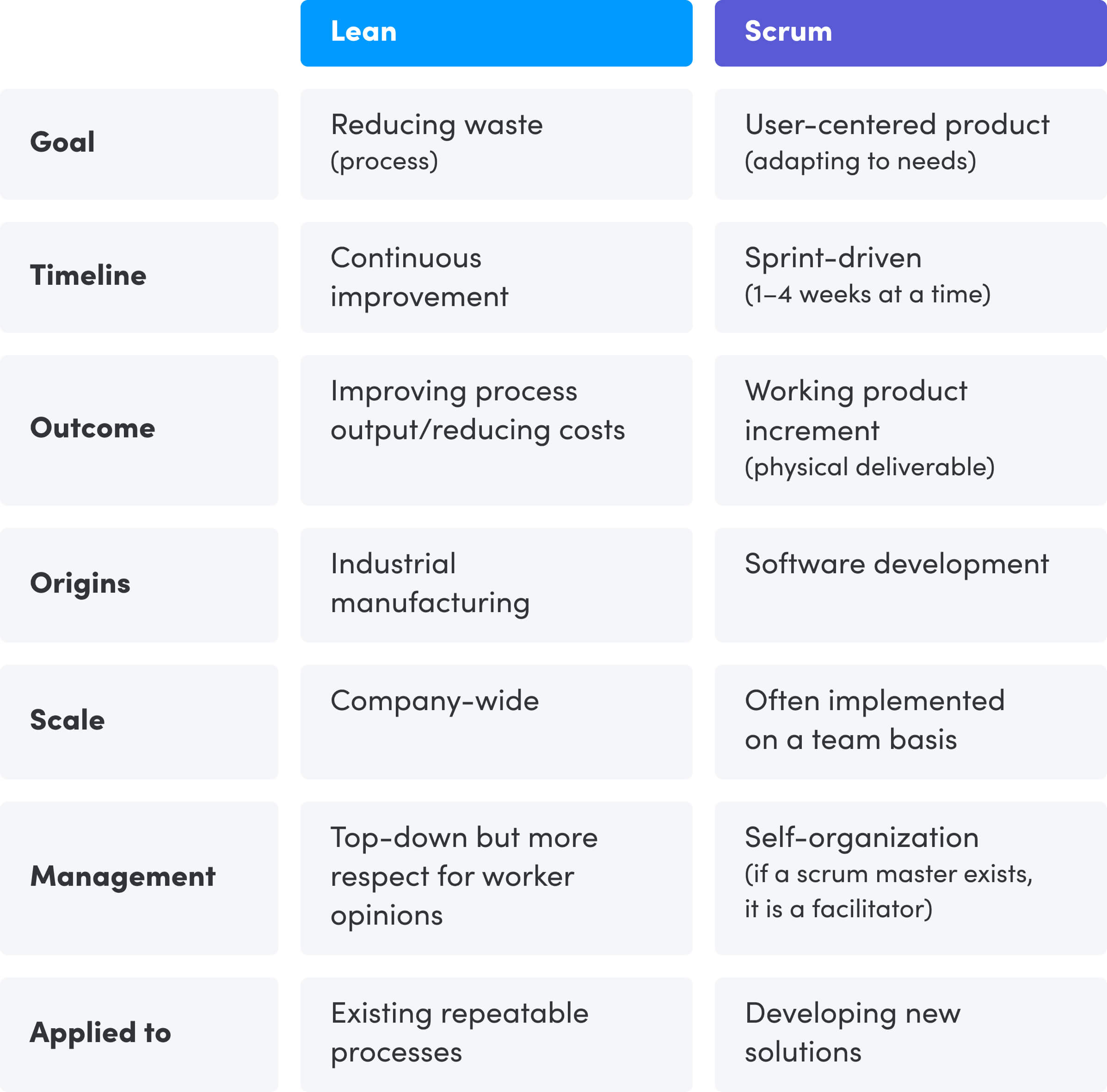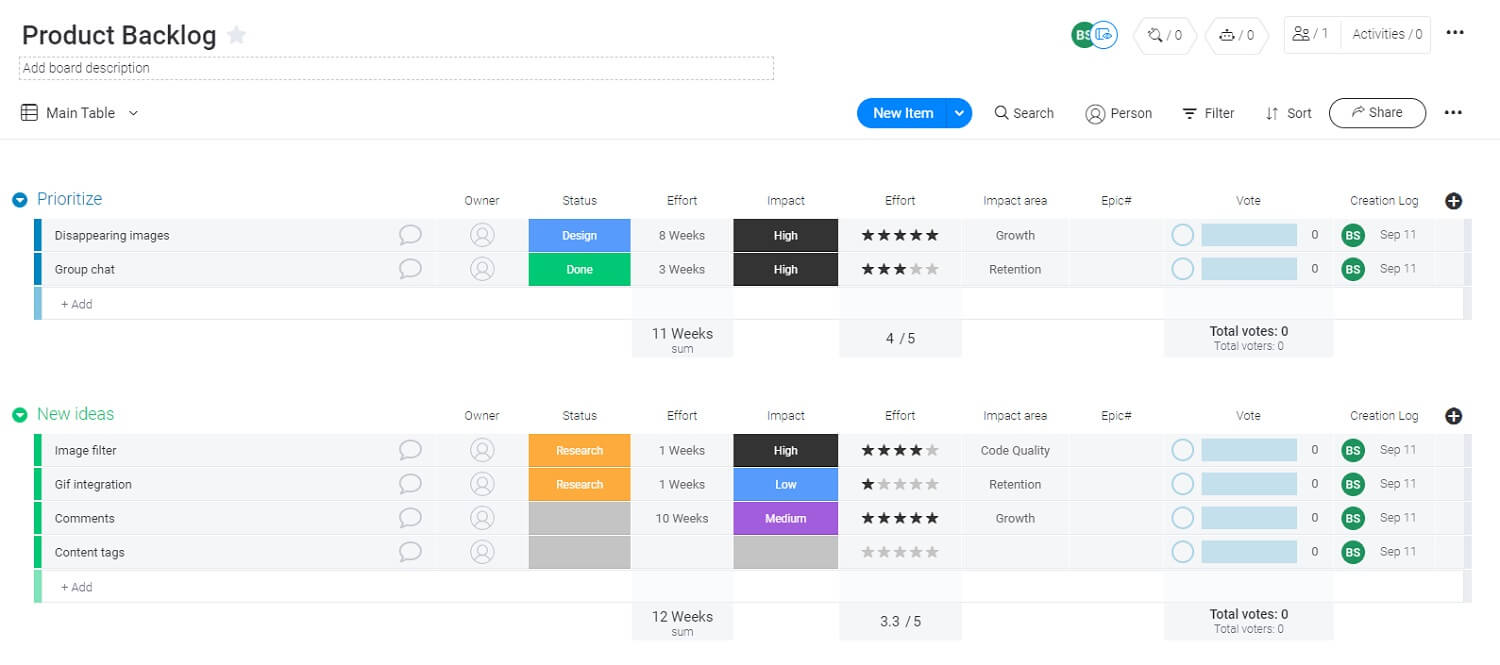With Agile, Lean, and Scrum trending hard, chances are you’ve at least heard the different terms before. But can you explain the difference? Do you even understand it?
Unfortunately, these complex methods have become buzzwords. And the terms are often used without the full understanding of what they really mean.
It’s like your best mate claiming that movie literally scared him to death. Unless you’re talking to a ghost, he’s a bit off the mark. If you want to learn the actual differences between Lean and Scrum and pitch one to your company, you’ve come to the right place.
In this article, we examine Lean vs Scrum, and explain all the key differences from values to implementation, helping you make the right choice for your company.
Lean vs. Scrum: The basics
Both Lean and Scrum focus on improving outdated project management methods and techniques.
Project management has become a hot topic and it’s easy to understand why. In 2019, only 18% of companies reported that their projects succeeded at least most of the time.
Scrum and Lean are both project frameworks designed to help improve your success rate. But they’ve taken distinctly different approaches as to how to solve the problem.
Scrum
Scrum is a framework for implementing the Agile methodology, where you divide larger projects into 1–4 week sprints, and work in a Scrum team of 3–9 people.
The whole point of Scrum is to scale down and repeat the production cycle. You plan, test, and review your product with actual customers multiple times, instead of once at the end. This creates a feedback loop that guides your product in the right direction and lets you ship products faster.
To learn more about the Scrum methodology, check out our in-depth guide.
Lean
The Lean methodology, on the other hand, is more of a philosophy or a guiding set of principles — not a framework. The main Lean principle is the reduction of waste through the continuous improvement of your processes.
Much like the Agile method, it’s often referred to as a project management methodology. But it’s the overall mindset behind different frameworks, rather than the how-to recipe, like Scrum.
Lean vs. Scrum: some key differences in 2022
While one of the main differences between the two is that Scrum is a tangible framework, Scrum also has a set of guiding principles and values that we can compare to Lean.
Let’s take a look at a few key aspects and how they compare side by side.

Lean is all about optimizing your ongoing processes and reducing waste. You will improve the value to your customers by delivering a product faster and cheaper.
Scrum is a shorter, more adaptive Agile approach for planning and production. You closely collaborate with customers and internal users and work in sprints. This leads to an end product more in line with your target audience, delivered faster, with less fluff.
Continuous improvement vs. sprints
Lean is all about improving the existing processes you have in your organization. Like with Kanban, the focus is on continuous improvement. Lean can go on indefinitely. Scrum is an Agile framework mostly used for new product development and breaks down each project into 1–4 week sprints. The average Scrum project length is 11.6 weeks.
Of course, there are not just differences between the two approaches. There are also similarities.
Lean vs. Scrum: Similarities
The greatest similarity is their foundation of heuristics and close collaboration between team members and customers.
The heuristic approach
Both Lean and Scrum denounce the idea of perfect up-front planning and simply following through. Instead, they preach implementing a heuristic approach. Essentially, you start with what you know about the project to create an initial plan, without trying to be perfect.Then, continually test your assumptions and adjust the plan based on new learnings and changing priorities.
In a sense, both are antidotes to the Waterfall methodology in their own way.
Daily morning meetings
Daily morning meetings are a staple in both Lean and Scrum. But who participates and what is discussed is different from one method to the other.
Daily Scrum meetings include all Agile team members, with no clear leaders and a simple agenda of focusing on progressing towards the sprint goal. The simplest formula takes the form of 3 questions: What I did yesterday, what I will do today, and what’s in my way.
Lean morning meetings are not quite as simple or universal. Paul Akers (the author of 2 Second Lean) offers a 22-page PDF document to help you structure your morning meetings. It includes a 21-point checklist on the first page.
Unless you’re the Flash, there’s no way you could tackle everything involved in a Lean meeting in the 15-minutes normally allocated for Scrum daily stand-ups.
Lean vs. Scrum: Which is right for you?
Don’t let the unwieldy meeting manual scare you off Lean. Both Scrum and Lean offer a lot of value.
Whether you should focus on going Lean or focus on Scrum depends on your goals, the size of your team, and existing customer relationships.
- Is your main business model selling existing products to a steady customer base?
- Would a small process improvement mean a big impact on your bottom line?
Internalize Lean thinking and optimize your business processes.
- Are you trying to develop a completely new product or software?
Adopt the Agile mindset with the Scrum framework.
You can also apply each option to different parts of your company.
For example, using Lean to evaluate processes for teams handling existing products, and Scrum for new product development.
Taking your first steps with Lean and Scrum
Whether you decide to get started with Lean or Scrum, there’s no need to start from scratch. There are many options online for copying and applying a specific method directly to your business.
For example, monday.com offers free customizable templates you can use to take your very first Lean or Agile steps.
Go Lean by managing your resources better
More efficiently managing resources so you can deliver better value to your customers is an essential part of the Lean methodology.

With a visual breakdown of how you’re using important assets, like trucks, buildings, and even people, it’s easier to identify waste.
Lean is all about improving your processes, so start recording and reviewing everything your company does now.
It’s only by challenging your assumptions that you can find a better way to do things. Lean teams improve their fundamental process one step at a time.
This resource management template is the perfect way to start capturing and tracking current processes.
Start building your product backlog for your first Scrum sprint
Rather than a “perfect” product plan with a timeline, stages, and features, Scrum starts with the product backlog instead.
It’s a list of features that your stakeholders (customers, internal users, and other people invested in your project) want. It helps solidify the shorter term product vision for your Scrum team.

Meet with your customers and everyone involved to start your own backlog, to make your first sprint planning a success.
Read our step-by-step guide if you want to learn more about actually holding your first Scrum sprint.
Our feature backlog template will help you build your first product and sprint backlog so you get you up and running quickly.
Choosing the right framework for your needs
There’s no universal answer to the question of whether Lean development or the Scrum approach to Agile project management is the better choice for your business.
It depends on your company size, business model, and many other factors. But one thing that’s almost 100% certain, is that your project management process has room for improvement.
monday.com has templates and features to help you improve your workflow, no matter which method you choose to work with.
FAQs
What's the difference between Scrum and Lean?
Whereas Scrum is a specific framework used for managing and completing projects in short sprints, Lean is a broader philosophy focused on continuous improvement and waste reduction in processes. Scrum focuses on iterative development and customer collaboration, and Lean targets process optimization and efficiency over time.
What is the difference between Lean and Agile?
Lean focuses on optimizing processes and eliminating waste, and Agile is a methodology that promotes iterative development, flexibility, and quick responses to changes. Whereas Agile embraces principles such as collaboration and adaptability, Lean takes a more holistic approach to process improvement and reducing inefficiencies.
What is the difference between Scrum and Lean Six Sigma?
Scrum is an Agile framework that structures work into short cycles called sprints, aiming for rapid delivery and regular feedback. Lean Six Sigma, on the other hand, combines Lean’s focus on waste reduction with Six Sigma’s goal of reducing process variation and improving quality. Whereas Scrum is more focused on project management, Lean Six Sigma targets overall process improvement and operational efficiency.
What is Lean thinking in Scrum?
Lean thinking in Scrum refers to applying Lean principles to the Scrum framework, such as reducing waste, improving flow, and focusing on delivering maximum value. By incorporating Lean into Scrum, teams can enhance efficiency, optimize processes, and streamline workflows to deliver higher-quality products more quickly.
